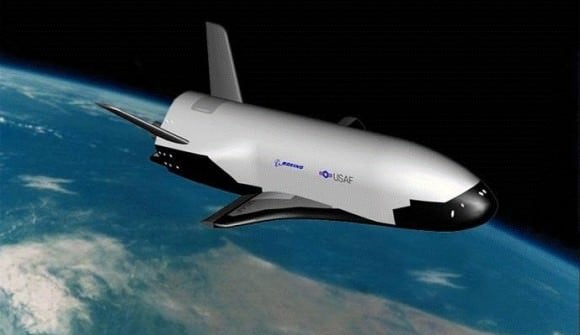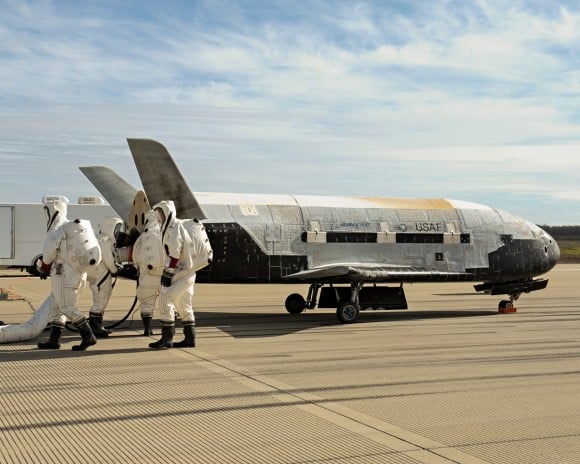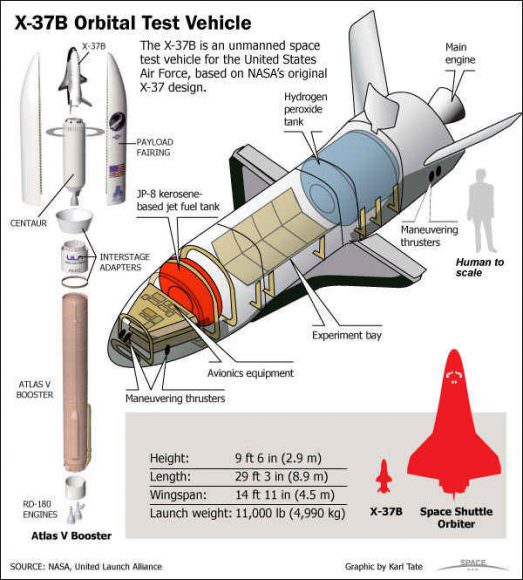For years now, the program to develop the X-37B spacecraft has been shrouded in secrecy. Originally intended as part of a NASA project to develop a reusable unmanned spacecraft, this Boeing-designed spaceplane was taken over by the Department of Defense in 2004. And while it has been successfully tested on multiple occasions, there remain some unanswered questions as to its intended purpose and what has been taking place during these flights.
This, predictably, has lead to all kinds of rumors and speculation, with some suggesting that it could be a spy plane while others think that it is intended to deliver space-based weapons. It's latest mission - which was dubbed OTV-4 (Orbital Test Vehicle-4) - has been especially clandestine. And after nearly a year in orbit, it remains unclear what the X37B has been doing up there all this time.
The mission began atop a Atlas V rocket which launched from Cape Canaveral Air Force Station on May 20th, 2015. As the second flight of the second X-37B vehicle, the stated purpose of mission was to test a
Hall-effect thruster
(HET) - a special type of ion thruster that NASA hopes to use on future satellites. The mission had the additional purposes of testing various materials in space for NASA, as well as experimental propulsion system developed by the US Air Force.
[caption id="attachment_111044" align="aligncenter" width="580"]
An artists' conception of the X-37B in Earth orbit. Credit: USAF
[/caption]
Sounds straightforward enough, doesn't it? But here is where the clandestine nature of things kicks in. Originally, the mission was expected to last about 200 days. But as of the penning of this article, the vehicle is going on 365 days in orbit, and no one is quite sure why or what it is doing up there. While the duration of OTV missions have been secret in the past, as well as the location of their landings, this prolonged stay in orbit is leading to more conjecture about the X-37Bs true purpose.
For instance, if the X-37Bs primary purpose is to test reusable space technologies, then it would make sense to land it before long. In this case, the key aspects of the mission would come down to the Air Force testing their ability to deploy and retrieve the spacecraft, as well as its ability to deliver scientific packages to orbit. This is certainly in keeping with the US Air Force's
fact sheet on the X-37B
, which sates that:
However, these aims seems incongruous will all the secrecy that surrounds the X-37B program, which is something one expects instead when dealing with the development of weapons systems. The long-terms stays in orbit also don't appear to be in keeping with this, as these would only prove useful if the intended spacecraft was meant to act as a satellite (i.e. remain in orbit for extended periods of time to collect information).
[caption id="attachment_120378" align="aligncenter" width="580"]
Fourth flight of the X-37B Orbital Test Vehicle is set for blastoff on May 20, 2015 from Cape Canaveral, Florida. Credit: Boeing
[/caption]
As a result, it has been widely speculated in the past few years that the true purpose of the X-37B is to act as a spy plane. As
Tom Burghardt
commented in his 2010 article, "
The Militarization of Outer Space: The Pentagon's 'Space Warriors'
", the development of the X-37B is part of the US Air Force's stated intention of maintaining "space superiority":
This was followed up in 2012 with allegations that the X-37B was spying on the Chinese
Tiangong-1
space station module. These claims were naturally denied by the US Air Force, which indicated that the orbits conducted by the test flight did not allow for any opportunities to conduct surveillance. This was backed up by space journalist and analyst Jim Oberg, who said in an interview
with the BBC
, "They are in orbits which cross the equator about 90 degrees apart. They crisscross each others' paths at thousands of meters per second. Any observation from one to the other is impossible."
Others have gone on record as stating that there is nothing particularly telling or alarming about the OTV missions, and that they are likely just the result of the USAF wanting to attempting to test the full capabilities of this new spacecraft. As Joan Johnson-Freese, a professor of national security affairs at the U.S. Naval War College in Newport, Rhode Island, recently told
Space.com
:
[caption id="attachment_128902" align="aligncenter" width="523"]
The interior of the X-37B spaceplane. Credit: Credit: Karl Tate/SPACE.com[/caption]
Nevertheless, the possibility that the X37B supports space-based espionage efforts remains a popular idea. For instance, Brian Weeden - a former air force officer and current technical adviser to the
Secure World Foundation
- has stated that he thinks the X-37B's mission is to test reconnaissance and spy sensors, particularly how they hold up against radiation and other hazards of orbit.
The possibility of it being used to capture satellites is also an enduring one. In 2014,
Alan Hulas
of Guardian stated, "The mystery of the plane centers around the purpose of an interior cavity," he wrote, "about the size of a truck bed and much too cozy for a human to live in for 674 days, the duration of its latest mission. The main theories suggest that the plane carries sensors and spy equipment, satellites or even weaponry."
Whatever the true purpose, the reactions towards the X-37B and the levels of secrecy surrounding it are not atypical. Whenever the issue of militarizing space emerges, it triggers fears about the prospect of a "space-weapons race". And since the Outer Space Treaty placed no bans on stationing conventional weapons in orbit, nor the stationing of spy satellites therein, there are no legal barriers to doing this.
Could the 21st century be a time where the US, Russia, China, and other major space players enter onto an arms race in space? Only time will tell. In the meantime, it might not be a bad idea to update the terms of the Outer Space Treaty and include some articles about secret spy spaceplanes!
 Universe Today
Universe Today



